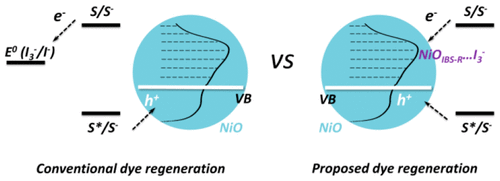当前位置:
X-MOL 学术
›
J. Am. Chem. Soc.
›
论文详情
Our official English website, www.x-mol.net, welcomes your
feedback! (Note: you will need to create a separate account there.)
Understanding the Role of Surface States on Mesoporous NiO Films
Journal of the American Chemical Society ( IF 14.4 ) Pub Date : 2020-10-16 , DOI: 10.1021/jacs.0c08886 Lei Tian 1 , Robin Tyburski 1 , Chenyu Wen 2 , Rui Sun 3 , Mohamed Abdellah 1, 4 , Jing Huang 1 , Luca D’Amario 1 , Gerrit Boschloo 1 , Leif Hammarström 1 , Haining Tian 1
Journal of the American Chemical Society ( IF 14.4 ) Pub Date : 2020-10-16 , DOI: 10.1021/jacs.0c08886 Lei Tian 1 , Robin Tyburski 1 , Chenyu Wen 2 , Rui Sun 3 , Mohamed Abdellah 1, 4 , Jing Huang 1 , Luca D’Amario 1 , Gerrit Boschloo 1 , Leif Hammarström 1 , Haining Tian 1
Affiliation

|
Surface states of mesoporous NiO semiconductor films have particular properties differing from the bulk and are able to dramatically influence the interfacial electron transfer and adsorption of chemical species. To achieve a better performance of NiO-based p-type dye-sensitized solar cells (p-DSCs), the function of the surface states has to be understood. In this paper, we applied a modified atomic layer deposition procedure that is able to passivate 72% of the surface states on NiO by depositing a monolayer of Al2O3. This provides us with representative control samples to study the functions of the surface states on NiO films. A main conclusion is that surface states, rather than the bulk, are mainly responsible for the conductivity in mesoporous NiO films. Furthermore, surface states significantly affect dye regeneration (with I–/I3– as redox couple) and hole transport in NiO-based p-DSCs. A new dye regeneration mechanism is proposed in which electrons are transferred from reduced dye molecules to intra-bandgap states, and then to I3– species. The intra-bandgap states here act as catalysts to assist I3– reduction. A more complete mechanism is suggested to understand the particular hole transport behavior in p-DSCs, in which the hole transport time is independent of light intensity. This is ascribed to the percolation hole hopping on the surface states. When the concentration of surface states was significantly reduced, the light-independent charge transport behavior in pristine NiO-based p-DSCs transformed into having an exponential dependence on light intensity, similar to that observed in TiO2-based n-type DSCs. These conclusions on the function of surface states provide new insight into the electronic properties of mesoporous NiO films.
中文翻译:

了解表面状态对介孔 NiO 薄膜的作用
介孔 NiO 半导体薄膜的表面状态具有不同于本体的特殊性质,能够显着影响界面电子转移和化学物质的吸附。为了获得基于 NiO 的 p 型染料敏化太阳能电池 (p-DSC) 的更好性能,必须了解表面状态的功能。在本文中,我们应用了一种改进的原子层沉积程序,该程序能够通过沉积单层 Al2O3 钝化 NiO 上 72% 的表面状态。这为我们提供了具有代表性的对照样品来研究 NiO 薄膜表面状态的功能。一个主要结论是,介孔 NiO 薄膜的导电性主要是由表面状态而不是体态造成的。此外,表面状态显着影响基于 NiO 的 p-DSC 中的染料再生(以 I–/I3– 作为氧化还原对)和空穴传输。提出了一种新的染料再生机制,其中电子从还原的染料分子转移到带隙内状态,然后转移到 I3-物种。这里的带隙内状态充当催化剂以帮助 I3– 还原。提出了一种更完整的机制来理解 p-DSC 中的特定空穴传输行为,其中空穴传输时间与光强度无关。这归因于在表面态上跳跃的渗透孔。当表面态浓度显着降低时,原始 NiO 基 p-DSC 中与光无关的电荷传输行为转变为对光强度具有指数依赖性,类似于在基于 TiO2 的 n 型 DSC 中观察到的情况。这些关于表面态函数的结论为了解介孔 NiO 薄膜的电子特性提供了新的见解。
更新日期:2020-10-16
中文翻译:

了解表面状态对介孔 NiO 薄膜的作用
介孔 NiO 半导体薄膜的表面状态具有不同于本体的特殊性质,能够显着影响界面电子转移和化学物质的吸附。为了获得基于 NiO 的 p 型染料敏化太阳能电池 (p-DSC) 的更好性能,必须了解表面状态的功能。在本文中,我们应用了一种改进的原子层沉积程序,该程序能够通过沉积单层 Al2O3 钝化 NiO 上 72% 的表面状态。这为我们提供了具有代表性的对照样品来研究 NiO 薄膜表面状态的功能。一个主要结论是,介孔 NiO 薄膜的导电性主要是由表面状态而不是体态造成的。此外,表面状态显着影响基于 NiO 的 p-DSC 中的染料再生(以 I–/I3– 作为氧化还原对)和空穴传输。提出了一种新的染料再生机制,其中电子从还原的染料分子转移到带隙内状态,然后转移到 I3-物种。这里的带隙内状态充当催化剂以帮助 I3– 还原。提出了一种更完整的机制来理解 p-DSC 中的特定空穴传输行为,其中空穴传输时间与光强度无关。这归因于在表面态上跳跃的渗透孔。当表面态浓度显着降低时,原始 NiO 基 p-DSC 中与光无关的电荷传输行为转变为对光强度具有指数依赖性,类似于在基于 TiO2 的 n 型 DSC 中观察到的情况。这些关于表面态函数的结论为了解介孔 NiO 薄膜的电子特性提供了新的见解。











































 京公网安备 11010802027423号
京公网安备 11010802027423号